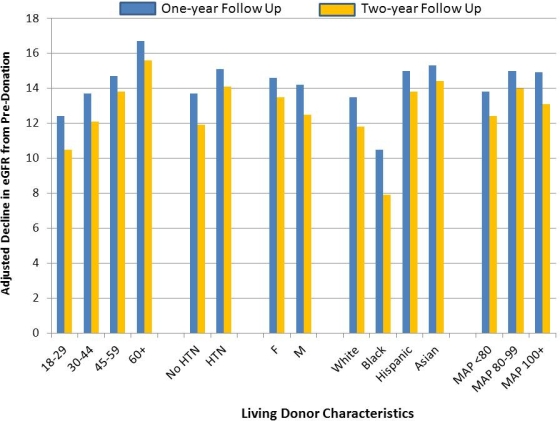Living Donor Characteristics Associated With Changes in Post-Donation GFR
1Nephrology and Hypertension, Cleveland Clinic, Cleveland, OH
2Qualitative Health Sciences, Cleveland Clinic, Cleveland, OH
3Urology, Cleveland Clinic, Cleveland, OH
4Division of Medicine, University of Wisconsin, Madison, WI
5Nephrology, University of Pennsylvania, Philadelphia, PA.
Meeting: 2015 American Transplant Congress
Abstract number: 100
Keywords: Donation, Glomerular filtration rate (GFR), Kidney
Session Information
Session Name: Concurrent Session: Kidney: Living Donor Issues I
Session Type: Concurrent Session
Date: Sunday, May 3, 2015
Session Time: 4:00pm-5:30pm
 Presentation Time: 4:36pm-4:48pm
Presentation Time: 4:36pm-4:48pm
Location: Terrace IV
Living donor transplantation is the preferred modality for treatment of ESRD because it confers excellent outcomes for recipients and poses reasonable risks to most donors. Post-donation GFR is an important measure because it might relate to long-term donor outcomes. Therefore we studied how donor characteristics relate to post-donation kidney function.
We identified living kidney donors from the national SRTR database between 2008-2012 (n=30,026). We examined changes in GFR (based on the CKD-EPI equation) from pre-donation measures to 1- and 2-years post-donation available on UNOS follow up forms. We utilized multivariable general linear models to estimate the distribution of changes in renal function and independent factors associated with level of change.
The mean decline in absolute donor eGFR from pre-donation to 1 and 2 years post-donation was -14.2±24.1 ml/min/1.73 m2 and -11.3±23.7 ml/min/1.73 m2, respectively. The median percent change in eGFR from baseline to these same two time points were -22% (IQR 1%-36%) and -12% (IQR 1%-32%). As displayed in the Figure, numerous factors were independently associated with greater declines in post-donation eGFR including older donor age, white and other donor races versus African American donors, female gender, history of hypertension, as well as higher pre-donation mean arterial blood pressure independent of the diagnosis of hypertension.
In conclusion, older donors, females and non-African American donors as well as those with elevated blood pressure demonstrate larger declines in eGFR following donation. Importantly, the overall mean percent decline in GFR is less than 25% during the first year and even lower at 2 years, suggesting that adaptation in the remnant kidney may continue over time.

To cite this abstract in AMA style:
Poggio E, Mandelbrot D, Reese P, Goldfarb D, Flechner S, Schold J. Living Donor Characteristics Associated With Changes in Post-Donation GFR [abstract]. Am J Transplant. 2015; 15 (suppl 3). https://atcmeetingabstracts.com/abstract/living-donor-characteristics-associated-with-changes-in-post-donation-gfr/. Accessed January 1, 2026.« Back to 2015 American Transplant Congress
